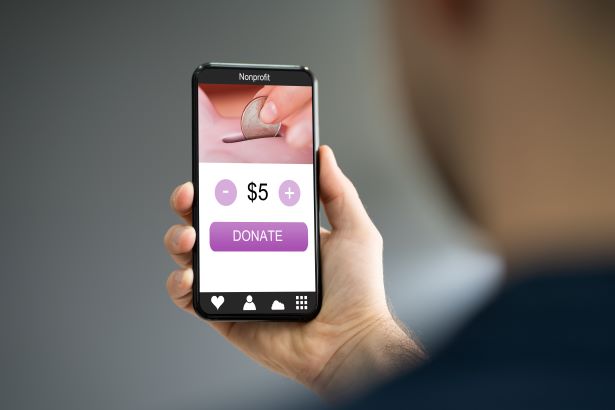
How to Add Text-to-Give to Your Fundraising Strategy

When it comes to leading a fundraising campaign, there are many strategies to help your nonprofit raise more money. Targeted email appeals, social media marketing, and direct mail can all be influential in driving fundraising results. However, if your nonprofit is looking to reach supporters effectively and surpass your fundraising expectations, text-to-give can take your fundraising strategy to the next level.
Text-to-give is a highly flexible and user-friendly approach to fundraising that can easily fit into your existing campaign strategies. With people now spending more time on their phones than ever before, it makes sense to leverage this into an opportunity to engage supporters and power more donations for your mission.
You may be wondering, what sets text-to-give apart from other fundraising strategies? Text-to-give guarantees that supporters will not only see your donation appeals, but will act on them quickly to make your mission a reality. In fact, text messages have a 99% open rate and 90% read rate within just three minutes of sending.
Whether you want to host a standalone text-to-give campaign or pair text fundraising with an existing fundraising event, these tips will help you get started:
- Partner with a text messaging platform.
- Market your campaign.
- Use storytelling.
With the right software and strong fundraising plan, your nonprofit will be in great shape to lead a powerful text-to-give campaign. Let’s begin.
Partner with a text messaging platform.
Before you can launch your next text-to-give campaign, you need to work with a trusted text messaging platform with fundraising experience. Tatango’s guide to nonprofit text messaging recommends looking for software with the following essential features:
A2P (Application to Person) messaging.
With so many supporters, it’s impossible for your nonprofit’s team to individually message each person. Instead, work with a solution that offers A2P messaging so you can mass send donation appeals, fundraising updates, and thank-you messages to thousands of supporters at once. This will streamline your nonprofit’s text messaging campaign and reduce your administrative burden.
Fast messaging speeds.
When you’re hosting fundraisers with a tight deadline, like Giving Tuesday, you need to reach supporters with your donation appeals reliably and quickly. Partner with a text messaging provider that will allow you to send text messages to thousands of recipients per second.
Security to protect your data.
Since your text messaging platform will store supporter contact information, it’s integral to protect this information in order to maintain donors’ trust in your organization. If a data leak occurs, your nonprofit could risk losing out on donor support, which will slow down your fundraising efforts and make it harder to advance your mission. Ensure your text messaging provider offers features like two-factor authentication and automated logout to safeguard your subscribers’ information.
Segmentation capabilities.
Segmentation is the process of dividing your supporters into contact lists based on shared characteristics. By creating segmented lists, your nonprofit will be able to tap into donors’ unique motivations and interests in supporting your nonprofit, making it more likely that donors will act on your donation request.
Look for a text messaging provider that offers high-level segmentation capabilities so you can segment your supporters by a number of factors, including donation amount, recency of opting into your campaign, donation frequency, and more.
Market your campaign.
Effective marketing is the key to any fundraising effort, but especially text-to-give fundraisers since you’ll need supporters to opt-in to your campaign. By sharing your designated code and keyword across a number of marketing channels, you’ll be able to get the word out about text-to-give and build your contact list.
Leverage these channels to bring attention to your campaign:
- Email. In your monthly email newsletter, highlight the benefits of text-to-give, including its added convenience for donors, and the steps to opt-in to your text messaging campaign.
- Social media. Introduce text-to-give through engaging multimedia content like graphic designs or even a video of someone signing up for your campaign. Adjust the type of content you share depending on each platform’s intuitive strengths. For example, Twitter is great for brief updates on fundraising progress, while Instagram is ideal for photos and videos that highlight why supporters should join your text-to-give campaign.
- Your nonprofit’s website. Prospective supporters will naturally explore your website when they want to learn more about your cause and how they can get involved. Use this opportunity to create a landing page dedicated to text-to-give opportunities, walking people through how to opt-in. In addition, include the option to subscribe to your text fundraising campaign on your email signup, event, and donation forms.
As you carry out your marketing strategy, track metrics like email clickthrough rates and social media reposts. This will help you understand the type of content that resonates the most with your audience so you can refine your approach as needed.
Use storytelling.
Text messaging can be highly effective in driving donations, but only if your messages resonate with donors and motivate them to give. This is where storytelling becomes an essential tool in crafting your text messages. According to Getting Attention’s guide to nonprofit marketing ideas, storytelling can help your nonprofit bring attention to the problem at hand and describe how supporters can become a part of solving this issue.
One of the most effective ways to tell a compelling story is by asking the donor to be the hero by giving a gift today. Rather than presenting a completed story and asking donors to help continue this important work, your organization should tell an unfinished story so the donor has a clear role to play. For example, an animal shelter could tell the story about a dog who was recently rescued off the streets but needs lifesaving care. In their call to action, this organization can emphasize how donors’ contributions are needed to save this dog’s life.
To support your story, include a powerful visual of your beneficiary. This stirs up passion for your cause and helps donors understand the tangible impact of their contributions. Continuing with the animal shelter example, this organization could share an image of the dog awaiting surgery to motivate donors to act quickly.
Since you have limited space in your text message, stick to the most essential elements of your story. Then, you can provide a link to a page on your website that goes more in depth, such as by featuring a video testimonial of your beneficiary sharing their experiences.
Many higher education institutions, churches, and nonprofits have achieved record fundraising success with the help of text-to-give. Your organization can be next by incorporating these best practices. Once you launch your text-to-give campaign, actively monitor metrics with the help of your text messaging provider so you can adjust your strategies as needed. Good luck!

